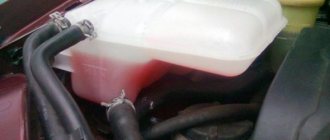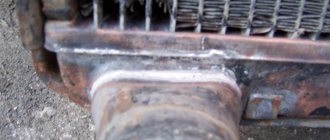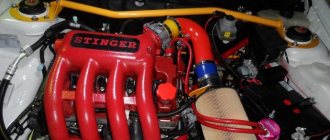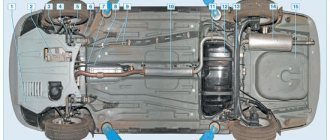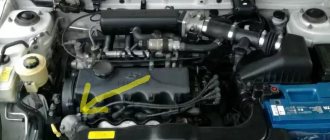Why do you need an expander?
To cool the engine, a special liquid based on propylene glycol or ethylene glycol (antifreeze or antifreeze) is used. These types of coolant have large thermal expansions. When the internal combustion engine operates, the coolant heats up and expands. If the cooling system did not use an expansion tank, then due to thermal expansion the radiators or pipes would fail due to excess pressure.
Broken expansion tank due to excess pressure in the system
The liquid in the expansion tank increases when heated and decreases when cooled. To prevent excessive pressure or vacuum from forming in the tank due to constant changes in coolant level, its lid is equipped with special valves that release or, on the contrary, allow air into the system in order to compensate for the load on the tank and maintain normal operating pressure.
Tank location
In Priora, the expansion tank is located under the hood on the left side in the direction of travel of the car, between the side member and the windshield. It has a rectangular shape with three or two fittings for SOD pipes.
- With two fittings it is used in Prioras with climate control (air conditioning).
- With three fittings in Priors without air conditioning.
Inside there are several partitions to strengthen the structure, which can withstand heavy loads.
The coolant level must be indicated on the tank, which should always be between the MIN and MAX marks.
Location of the expansion tank on the Lada Priore car
The main function of the expansion tank is to compensate for evaporated antifreeze in the engine cooling system. In the Lada Priora car, the tank is located under the hood on the driver's side.
The expansion tank is located under the hood on the left (in the direction of travel) side
It is simply impossible not to notice the coolant reservoir: it is closest to the windshield of all other elements.
About the cover
Special attention should be paid to the expander cover. At first glance, the lid does not have anything special, but if you look closely, you will notice that it has an unusual bottom. It contains two valves that operate under specific conditions. As described above, one of the valves releases excess pressure when the engine is hot, and the second, on the contrary, lets air in when the engine cools down.
The serviceability of the cap is the key to the correct operation of the SOD and the integrity of the expansion tank.
Tank failures and their causes
The main damage to the expander is cracks or abrasions. Quite often, cracks in the tank form near the fittings, and abrasions appear on the lower part. This occurs due to engine vibrations in the engine compartment due to uneven roads.
- Clutch master cylinder VAZ 2106: replacement and installation
Sometimes it happens that the expander bursts due to excess pressure in the system; this will be caused by a faulty cap, or rather its valve, which did not release the pressure at the right time.
If one of these problems is detected, the expansion tank must be replaced.
Causes of failure of VAZ 2110-2115 tanks
Inflates the coolant reservoir of the VAZ 2114.
The service life of this element is not limited by regulations. This means that the container should be changed as needed, and this occurs quite often. The most common reason for replacement is damage to the integrity of the plastic case during operation. The tank simply bursts and here's why:
- Clogged or damaged lid valve. The steam coming from the radiators increases the pressure inside the tank because it cannot escape through the plug. As a result, the wall of the container is destroyed.
- In VAZ 2110-12 cars, the side walls of the vessel are closely adjacent to the body elements - the glass and the partition. As the antifreeze temperature and pressure in the system increase, the plastic has nowhere to swell, causing the body to burst along the seam at the end (usually in the lower corner).
- In the event of a breakdown of the gasket between the cylinder head and the engine block, the cooling system is subjected to a series of water hammers created by the movement of the pistons. The plastic case also often bursts from such an impact.
- The reason may be the expansion tank itself, made from low-quality raw materials or in violation of plastic molding technology.
To avoid destruction of the expansion tank, it is recommended to check the functionality of the plug valve before each long trip. Practice shows that problems with the tank most often arise on the road, when it is hot outside, that is, in the summer. A sign of a malfunction is a sharp increase in coolant temperature and a puddle under the engine compartment on the driver’s side.
Replacement
To carry out the work, you do not need any special knowledge of automotive mechanics; after reading our instructions, you will easily carry out this work. For faster and trouble-free dismantling and installation of the tank, you need to prepare the necessary tools. It is also recommended to replace the cap along with the tank.
Tool for work:
- Crosshead screwdriver;
- Sealant;
- Container for draining the coolant (a two-liter bottle with the neck cut off will do);
Work procedure
It is necessary to allow the engine to cool down to avoid burns during operation.
- Unscrew the clamp of the lower fitting and drain the coolant into a prepared container. It is necessary to drain the liquid only from the expander. Then we fix the removed pipe in a vertical position so that the remaining coolant does not leak out.
- We unscrew the clamps of the remaining pipes and remove them, also fixing them in a vertical position.
- We remove the tank by pressing on the right side and pulling the left up, it should look like in the picture.
- Install the new one in the reverse order of removal. It is recommended to apply a small amount of sealant to the fittings for better tightness of the system.
- We add the remaining coolant, start the engine and warm it up to 90°C, after which we check the tightness of the system.
The process of replacing the expansion tank on the Lada Priora has been completed, as you can see there is nothing complicated about it.
Why do you need an expansion tank?
The task of the expansion device installed in the Lada Priora is to compensate for the coolant, the volume of which increases or decreases in accordance with temperature changes. The design of the product consists of the following functional parts:
- There are marks on the body that regulate the level of antifreeze - minimum value and maximum.
- The lid is located at the very top, which allows you to completely close the neck.
- Sealing is achieved with a plastic plug; valves are equipped, making up one block responsible for inlet and outlet.
Step-by-step guide to replacing the expansion tank in Lada Priora
To remove and install the expansion tank in the Lada Priora, follow the step-by-step instructions:
- You will need a Phillips head screwdriver. First remove the reservoir cap. To make the lid easy to manipulate, turn the drain plug located at the bottom of the radiator tank on the right. Next, drain all the liquid.
- Remember the important rule for draining antifreeze - it is unacceptable to mix different coolants with each other.
- Turn the drain plug a little. Please note that when draining antifreeze from the radiator unit, liquid will also come out of the tank.
- Loosen the clamp securing the steam exhaust hose of the heater radiator, and then remove the hose from the fitting.
- Remove the steam exhaust hose from the radiator of the engine cooling system.
- To remove the reservoir, move it upward and slide the rear panel away from the recess of the engine shield trim.
- Drain off any remaining antifreeze.
- Install the new unit using the reverse sequence.
The expansion tank is an important element of the engine cooling system. It has an extremely simple design and rarely fails. Nevertheless, every car owner should know the procedure to follow if damage to the tank is detected.
Replacing the expansion tank on the Lada Priora
Every driver may encounter the problem of a decrease in the coolant level in the expansion tank. One of the reasons for this may be a leak in the expansion tank. First of all, cracks appear at the joints and at the base of the tank fittings. In this case, the expansion tank must be immediately replaced with a new one.
The step-by-step instructions provided will help you make the replacement.
Replacement requires a Phillips and flat head screwdriver.
We disconnect the cooling system pipes from the expansion tank and drain the remaining coolant in the tank into a previously prepared container. The expansion tank is secured only with metal clamps, but its removal is hampered by the windshield frill. Therefore, it is necessary to partially disassemble the frill.
Loosen the right side of the frill by unscrewing 4 screws under the plugs and 4 self-tapping screws under the rubber seal.
We pull out the expansion tank towards the left wing.
We clean the area under the expansion tank from dirt and, if necessary, straighten the deformed metal clips.
We install the new expansion tank in the same way from the left wing, being careful not to damage the plastic fittings.
We assemble the frill in the reverse order. We connect the cooling system pipes, having previously cut off the deformed ends.
If necessary, immediately change the cooling system pipes, the pipe clamps and the expansion tank cap.
(2 ratings) Loading...
Expansion tank device
The manufacturer installs expansion tanks produced by Plastik LLC on the Lada Priora car. They are made of translucent white plastic. A scale showing the coolant level must be applied to the front wall of the tank.
- Thermostat for VAZ 2115 - device, replacement and repair
The Max and Min marks show the level of antifreeze in the tank
The tank is closed with a lid, which simultaneously measures the antifreeze pressure in the cooling system. The lid is located on the neck at the top of the tank. It is made of plastic and, for its part, reliably seals the cooling system.
Few people know, but a pair of valves are built into the tank lid. Each of them operates under certain conditions, which allows you to compensate for the amount of coolant at the moment it boils or cools.
Expansion tanks made in Russia are distinguished by their strength and durability. Their cost depends on the design features of the case (from 300 rubles and above).
Lada Priora cars are equipped with the simplest domestic coolant tanks
replacing the expansion tank on a LADA Priora: how to remove and replace, how much does a new one cost?
The expansion tank is an important element of the engine cooling system. It has an extremely simple design and rarely fails. Nevertheless, every car owner should know the procedure to follow if damage to the tank is detected.
Expansion tank device
The manufacturer installs expansion tanks produced by Plastik LLC on the Lada Priora car. They are made of translucent white plastic. A scale showing the coolant level must be applied to the front wall of the tank.
The Max and Min marks show the level of antifreeze in the tank
The tank is closed with a lid, which simultaneously measures the antifreeze pressure in the cooling system. The lid is located on the neck at the top of the tank. It is made of plastic and, for its part, reliably seals the cooling system.
Few people know, but a pair of valves are built into the tank lid. Each of them operates under certain conditions, which allows you to compensate for the amount of coolant at the moment it boils or cools.
Expansion tanks made in Russia are distinguished by their strength and durability. Their cost depends on the design features of the case (from 300 rubles and above).
Lada Priora cars are equipped with the simplest domestic coolant tanks
Replacing the expansion tank
Tightness is the main condition for the operation of the expansion tank. Therefore, the only reason for replacing it can be a hole or crack in the housing.
Replacing the expansion tank
Tightness is the main condition for the operation of the expansion tank. Therefore, the only reason for replacing it can be a hole or crack in the housing.
Required Tools
To replace the expansion tank, you will need a Phillips screwdriver and a container to drain the coolant.
To remove the expansion tank you will need a small Phillips screwdriver
Operating procedure
Removing the expansion tank should only be done on a cold engine. After the trip, the car must stand for several hours so that the antifreeze cools completely.
The replacement procedure is as follows.
- Remove the plug located at the bottom of the tank on the right side.
- Drain the entire volume of coolant from the resulting hole into a previously placed container.
- After draining the coolant, replace the plug.
- Use a Phillips screwdriver to loosen the clamp on the steam outlet pipe.
- Remove the pipe from the tank fitting.
- Use a Phillips screwdriver to loosen the clamp on the filling hose.
- Remove the hose from the second tank fitting.
- Remove the expansion tank. To do this, pull it up while simultaneously pulling the rear edge of the tank out of the recess in the lining.
- Install a new tank.
- Connect the coolant supply hose first, then the steam exhaust hose. Secure the hoses with new clamps.
- Pour antifreeze into the new expansion tank.
Video: replacing the expansion tank
When changing the expansion tank, do not change the coolant arbitrarily. It is necessary to fill in the same antifreeze (or antifreeze) that is already in the system.
After replacing the tank, you need to start the engine and warm it up to operating temperature at idle speed. This is necessary to check the tightness of the new clamp connections and remove air pockets in the cooling system.
If, when heated to 90°C, no coolant leakage is detected at the hose connections to the reservoir, the cooling system is completely sealed.
If a coolant leak in the tank hoses is not detected when heated to 90 degrees, then the tightness of the cooling system is not compromised
The process of replacing the expansion tank on a Lada Priora car is extremely simple even for a novice car enthusiast. Usually the whole job takes no more than 15 minutes.
Home → Maintenance and Repair → Repair → Home→Catalogue→Engine→Cooling system→Radiator and expansion tank→Expansion tanks→Expansion tank VAZ-2113-15 (Polymer)Expansion tank VAZ-2113-15 Characteristics
| Supplier code: | 029885 |
| Vendor code: | 2108-3-1311014-00 |
| Requisites: | Product, Product, 00-00006112, Expansion tank VAZ-2113-15, 0.27 |
| Basic unit: | PC |
| Tax rates: | Tax free |
| Manufacturer: | LLC "Polymer" |
Expansion tank VAZ-2113-15 (Polymer) In stock ( 10 )90 RUR + 2.7 to the bonus account Expansion tank VAZ-2110 old model (Master-M) Expansion tank VAZ-2110 old model (Master-M) Characteristics
| Supplier code: | 223765 |
| Vendor code: | 2110-1311014 |
| Requisites: | Tovar, Tovar, 00-00033242, Expansion tank VAZ-2110 old (Master-M), 0.22 |
| Basic unit: | PC |
| Tax rates: | 18 |
| Manufacturer: | LLC "Partner-NK" |
Expansion tank VAZ-2110 old (Master-M) In stock ( 10 )120 RUR + 3.6 for bonuses Expansion tank VAZ-2170 without hose (2 fittings) (Master-M) Expansion tank VAZ-2170 without hose ( 2 fittings) (Master-M) Characteristics
| Supplier code: | 223777 |
| Vendor code: | 2170-1311010 |
| Requisites: | Tovar, Tovar, 00-00027880, Expansion tank VAZ-2170 (Master-M) without hose, 0.46 |
| Basic unit: | PC |
| Tax rates: | Tax free |
| Manufacturer: | LLC "Partner-NK" |
Expansion tank VAZ-2170 without hose (2 fittings) (Master-M) In stock ( 50 )250 RUR + 7.5 for bonuses Expansion tank VAZ-21083 assembled (hose, sensor) (Vital) Expansion tank VAZ-21083 in assembly (hose, sensor) (Vital)Characteristics
| Supplier code: | 186337 |
| Vendor code: | 21083-1300060-10 |
| Requisites: | Tovar, Tovar, 00-00006111, VAZ-21083 expansion tank assembly (hose, sensor) (Vital), 0.5 |
| Basic unit: | PC |
| Tax rates: | Tax free |
| Manufacturer: | Vital CJSC |
Expansion tank VAZ-21083 assembled (hose, sensor) (Vital) Out of stock 590 RUR + 17.7 for bonuses Expansion tank VAZ-2108 (Polymer) Expansion tank VAZ-2108 Characteristics
| Supplier code: | 029884 |
| Vendor code: | 2108-1311014-00 |
| Requisites: | Product, Product, 00-00019593, Expansion tank VAZ-2108, 0.25 |
| Basic unit: | PC |
| Tax rates: | 18 |
| Manufacturer: | LLC "Polymer" |
Expansion tank VAZ-2108 (Polymer) In stock ( 24 )90 RUR + 2.7 to the bonus account Expansion tank VAZ-2110 new. arr (Polymer)Characteristics
| Supplier code: | 029886 |
| Vendor code: | 2110-1311014-11 |
| Manufacturer: | LLC "Polymer" |
Expansion tank VAZ-2110 new. mod (Polymer) In stock ( 35 )100 RUR + 3 to the bonus accountExpansion tank with pipelines assembled VAZ-2170 (Auto component)Expansion tank with pipelines assembled VAZ-2170 (Auto component)Characteristics
| Supplier code: | 391993 |
| Vendor code: | 2170-1300060 |
| Requisites: | Tovar, Tovar, 00-00030452, Expansion tank VAZ-2170 bare (under air conditioning) (Syzran), 0.45 |
| Basic unit: | PC |
| Tax rates: | 18 |
| Manufacturer: | LLC "Plant Avtokomponent" |
Expansion tank with pipelines assembled VAZ-2170 (Autocomponent) Out of stock 480 RUR + 14.4 for bonuses Expansion tank VAZ-1118 (Master-M) Expansion tank VAZ-1118 (Master-M) Characteristics
| Supplier code: | 223778 |
| Vendor code: | 1118-1311010 |
| Requisites: | Tovar, Tovar, 00-00033241, Expansion tank VAZ-1118 (Master-M), 0.39 |
| Basic unit: | PC |
| Tax rates: | 18 |
| Manufacturer: | LLC "Partner-NK" |
Expansion tank VAZ-1118 (Master-M) In stock ( 100 )210 RUR + 6.3 to the bonus account Expansion tank VAZ-2110 old model (Polymer) Expansion tank VAZ-2110 old model (Samara)Characteristics
| Supplier code: | 033442 |
| Vendor code: | 2110-1311014-02 |
| Requisites: | Tovar, Tovar, 00-00030451, Expansion tank VAZ-2110 old model (Samara), 0.22 |
| Basic unit: | PC |
| Tax rates: | 18 |
| Manufacturer: | LLC "Polymer" |
Expansion tank VAZ-2110 old (Polymer) In stock ( 10 )90 RUR + 2.7 to the bonus account Expansion tank VAZ-2170 assembled Characteristics
| Supplier code: | 029889 |
| Vendor code: | 2170-1300060-00 |
| Basic unit: | PC |
| Manufacturer: | JSC "Plastic", Syzran |
Expansion tank VAZ-2170 assembled In stock ( 10 )260 RUR + 7.8 for bonusesExpansion tank VAZ-21083 (Master-M)Expansion tank VAZ-21083 (Master-M)Characteristics
| Supplier code: | 223764 |
| Vendor code: | 21083-1311014 |
| Requisites: | Tovar, Tovar, 00-00028276, Expansion tank VAZ-21083 (Master-M), 0.27 |
| Basic unit: | PC |
| Tax rates: | 18 |
| Manufacturer: | LLC "Partner-NK" |
Expansion tank VAZ-21083 (Master-M) In stock ( 50 )145 RUR + 4.35 to the bonus accountExpansion tank VAZ-1118 (Autocomponent)Characteristics
| Supplier code: | 391992 |
| Vendor code: | 1118-1311010-10 |
| Basic unit: | PC |
| Manufacturer: | LLC "Plant Avtokomponent" |
Expansion tank VAZ-1118 (Autocomponent) In stock ( 100 )335 RUR + 10.05 to the bonus accountExpansion tank VAZ-2170 for air conditioning (without hose, 1 fitting) SyzranCharacteristics
| Supplier code: | 244421 |
| Vendor code: | 2170-1311010-10 |
| Manufacturer: | JSC "Plastic", Syzran |
Expansion tank VAZ-2170 for air conditioning (without hose, 1 fitting) Syzran In stock ( 10 )210 RUR + 6.3 for bonusesExpansion tank VAZ-2123 (Master-M)Expansion tank VAZ-2123 (Master-M)Characteristics
| Supplier code: | 223775 |
| Vendor code: | 2123-1311014 |
| Requisites: | Tovar, Tovar, 00-00028278, Expansion tank VAZ-2123 (Master-M), 0.25 |
| Basic unit: | PC |
| Tax rates: | 18 |
| Manufacturer: | LLC "Partner-NK" |
Expansion tank VAZ-2123 (Master-M) In stock ( 50 )145 RUR + 4.35 to the bonus account Expansion tank hose VAZ-2108 BRT Expansion tank hose VAZ-2108 BRT Characteristics
| Supplier code: | 017959 |
| Vendor code: | 2108-1303080 |
| Requisites: | Product, Product, 00-00028349, Expansion tank hose VAZ-2108 BRT0 |
| Basic unit: | PC |
| Tax rates: | 18 |
| Manufacturer: | BRT OJSC |
Expansion tank hose VAZ-2108 BRT In stock ( 10 )100 RUR + 3 for bonuses Expansion tank VAZ-2101, G-2410 (Master-M) Expansion tank VAZ-2101, G-2410 (Master-M) Characteristics
| Supplier code: | 223762 |
| Vendor code: | 2101-1311014 |
| Requisites: | Product, Product, 00-00028274, Expansion tank VAZ-2101, G-2410 (Master-M), 0.2 |
| Basic unit: | PC |
| Tax rates: | 18 |
| Manufacturer: | LLC "Partner-NK" |
Expansion tank VAZ-2101, G-2410 (Master-M) In stock ( 50 )115 RUR + 3.45 to the bonus account Expansion tank VAZ-2108 (Master-M) Expansion tank VAZ-2108 (Master-M) Characteristics
| Supplier code: | 223763 |
| Vendor code: | 2108-1311014 |
| Requisites: | Tovar, Tovar, 00-00028275, Expansion tank VAZ-2108 (Master-M), 0.25 |
| Basic unit: | PC |
| Tax rates: | 18 |
| Manufacturer: | LLC "Partner-NK" |
Expansion tank VAZ-2108 (Master-M) In stock ( 10 )145 RUR + 4.35 to the bonus account Expansion tank hose VAZ-2108-15 engineer. BRThose expansion tank VAZ-2108-15 engineer. BRTCharacteristics
| Supplier code: | 074982 |
| Vendor code: | 21082-1303080-R |
| Requisites: | Product, Product, 00-00028350, Expansion tank hose VAZ-2108-15 engineer. BRT0 |
| Basic unit: | PC |
| Tax rates: | 18 |
| Manufacturer: | BRT OJSC |
Expansion tank hose VAZ-2108-15 engineer. BRT In stock (50)110 RUR + 3.3 to the bonus account Expansion tank VAZ-2123 Specifications
| Supplier code: | 285853 |
| Vendor code: | 2123-1311014 |
| Manufacturer: | JSC "Plastic", Syzran |
Expansion tank VAZ-2123 In stock ( 50 )150 RUR + 4.5 for bonuses Expansion tank VAZ-1118 Characteristics
| Supplier code: | 033443 |
| Vendor code: | 1118-1311010-00 |
| Manufacturer: | JSC "Plastic", Syzran |
Expansion tank VAZ-1118 In stock (10)250 RUR + 7.5 towards bonus account
Home | Prev. | 1
23 | Track. | End
Withdraw by:2020406080100
It would seem, what is so important about such a device as an expansion tank for coolant (coolant). But if you take a closer look, it turns out that this part performs not only the function of storing antifreeze.
It is believed that the Priora expansion tank simply stores excess tasol. However, this is not quite true. Cars equipped with “injectors” themselves are high-temperature. In addition to the need for timely cooling, the system must maintain a certain pressure. Both the circulation of the coolant and the lower boiling point of antifreeze in the engine depend on this. With proper pressure, the engine runs reliably at 105 degrees.
Important! This is why you should not use ordinary water to fill the cooling system of “injection” machines. After all, water already boils at 95 degrees. And the computer will turn on the fan only at 103 degrees!
Replacing the expansion tank on VAZ 2110-2115 cars with your own hands
The water cooling system of VAZ cars of the “tenth” family necessarily includes a plastic expansion tank. When the volume of antifreeze increases as a result of heating, its excess flows into this container. The second function of the element is to remove steam and excess pressure through a plug with a valve. The problem is that on “tens” tanks often fail and car owners have to change them. The replacement procedure is not complicated and can be easily done with your own hands.
Location of expansion tank
A plastic reservoir for excess coolant is installed by the manufacturer in different places depending on the model of the “tenth” family:
- in cars of the VAZ 2110-12 series, the reservoir is located on the left side (in the direction of travel) between the pillar glass and the wall of the interior partition; The expansion tank on VAZ 2110-12 models is installed in a narrow niche on the driver’s side
- in VAZ 2114-15 cars, the tank is also located on the driver’s side, but is placed in front of the pillar glass. In cars of the 2114-2115 series, the tank is located in front of the pillar
The expansion tank is attached to the body elements with a clamp in the form of a flat rubber belt with a metal hook that hooks onto a protrusion on the side member. There are 3 hoses connected to the tank:
- A large diameter pipe leading from the thermostat is connected to the bottom.
- The upper tube of small diameter goes through the partition to the radiator of the cabin heater.
- The middle small tube connects the tank to the upper fitting of the main cooling radiator.
The reservoir compensates for the expansion of coolant and steam from three elements of the system - the cabin heater, the radiator and the main line near the thermostat
On some modifications there is a reservoir with two fittings and connecting pipes - the large one comes from the thermostat, and the small one from the main radiator; there is no connection to the stove.
Each hose performs a separate function. The thick pipe serves to expand the coolant and fill the system while pouring antifreeze through the neck of the tank. Two thin tubes are designed to drain the steam-water mixture from the stove and the main radiator into the tank when heated to the maximum permissible antifreeze temperature of 95 ° C.
The expansion tank (item 1) is located at the highest point of the cooling system at the same level as the throttle valve
Causes of failure of VAZ 2110-2115 tanks
The service life of this element is not limited by regulations. This means that the container should be changed as needed, and this occurs quite often. The most common reason for replacement is damage to the integrity of the plastic case during operation. The tank simply bursts and here's why:
- Clogged or damaged lid valve.
The steam coming from the radiators increases the pressure inside the tank because it cannot escape through the plug. As a result, the wall of the container is destroyed. Damage to the plastic wall occurs due to excess pressure in the cooling system - In VAZ 2110-12 cars, the side walls of the vessel are closely adjacent to the body elements - the glass and the partition. As the antifreeze temperature and pressure in the system increase, the plastic has nowhere to swell, causing the body to burst along the seam at the end (usually in the lower corner).
- In the event of a breakdown of the gasket between the cylinder head and the engine block, the cooling system is subjected to a series of water hammers created by the movement of the pistons. The plastic case also often bursts from such an impact.
- The reason may be the expansion tank itself, made from low-quality raw materials or in violation of plastic molding technology.
On low-quality products, cracks may appear 3-6 months after the start of use.
To avoid destruction of the expansion tank, it is recommended to check the functionality of the plug valve before each long trip. Practice shows that problems with the tank most often arise on the road, when it is hot outside, that is, in the summer. A sign of a malfunction is a sharp increase in coolant temperature and a puddle under the engine compartment on the driver’s side.
Experienced drivers advise replacing the standard tank cap with the cap from previous VAZ 2109-099 models. They are much more reliable in operation and fit the thread. Just keep one thing in mind: in some car configurations the plug is equipped with an antifreeze level sensor. After such a replacement, you will not be able to control it, although this will not affect the performance of the cooling circuit.
Recommendations for selection
For VAZ 2110-12 models, you can find 2 types of expansion tanks on sale:
- old-style with two necks: the coolant level sensor is screwed into the first, and the second is closed with a plug with a release valve; On old-style products, a second neck is made for installing an antifreeze level sensor
- a new type with one neck (without a sensor) and a body convex on the sides. The container of the new type does not have a level sensor
If your car has a sensor in an expansion tank, then you need to select an old-style product. Accordingly, versions without a sensor will require a new reservoir design.
For VAZ 2114-15 models, tanks of the same shape are offered with 3 fittings: two of them are located at one end, and the third is located at the opposite end. Products for the VAZ 2110 and 2114 are not interchangeable with each other, although if you really want to, attaching a part from another model is quite possible. Another thing is that there is no need for this - both varieties are available for free sale and practically do not differ in price.
The reservoir for models 2114-15 has a wider shape and a versatile arrangement of fittings
When purchasing an expansion tank for any series of cars of the “tenth” family, pay attention to the following points:
- the plastic of a quality product should be light and half transparent;
- cracks in the corners or near the fittings are unacceptable;
- the plastic should not be “oaky” or have dark impurities visible to the naked eye;
- look on the body for an imprint of the manufacturer's trademark and catalog number (21083–1311014 for VAZ 2114).
FEATURES OF THE EXPANSION TANK
This device has two main parts:
- The case is plastic.
- Cover with pressure valve.
The quality of the plastic used to make the case plays a special role. Maintaining the pressure required by the system depends 50% on its plasticity.
Attention! When purchasing a new expansion tank, you must carefully check the quality of the connections at the joints! It is in these places that antifreeze under pressure can break through.
EXPANDER CONFIGURATION
It has four holes. The lower, large outlet is the pipe for the coolant to enter the line. Small tubes are used to return tasol from the area of the heater radiator and thermostat pipe. Well, and the main neck, which is closed with a special lid. But the remaining 50% is ensured by the correct operation of the valve in the expansion tank cap.
HOW THE EXPANSION RESERVOIR COVER WORKS
The principle of its operation is relatively simple. It is based on a soldier valve system. That is, in the system, pressure rises from heating and expansion of the coolant. The spring in the cover is adjusted in such a way that when the optimal value is reached, the valve opens and releases excess air in the cooling system. In this case, air should flow freely in the opposite direction. This allows the components to be preserved during cooling. For example, when the engine is turned off.
WHERE IS THE ANTIFREEZE EXPANSION TANK LOCATED?
In the engine compartment. Right behind the battery. Above the right side member of the Priora there is a plastic housing for this part. The three pipes listed above are suitable for it. One below, on the left. And two small ones at the top left. On the wide side facing the engine compartment.
Expansion tank from Priora and modification of the cover
The service life of this element is not limited by regulations. This means that the container should be changed as needed, and this occurs quite often. The most common reason for replacement is damage to the integrity of the plastic case during operation. The tank simply bursts and here's why:
- Clogged or damaged lid valve. The steam coming from the radiators increases the pressure inside the tank because it cannot escape through the plug. As a result, the wall of the container is destroyed.
- In VAZ 2110-12 cars, the side walls of the vessel are closely adjacent to the body elements - the glass and the partition. As the antifreeze temperature and pressure in the system increase, the plastic has nowhere to swell, causing the body to burst along the seam at the end (usually in the lower corner).
- In the event of a breakdown of the gasket between the cylinder head and the engine block, the cooling system is subjected to a series of water hammers created by the movement of the pistons. The plastic case also often bursts from such an impact.
- The reason may be the expansion tank itself, made from low-quality raw materials or in violation of plastic molding technology.
To avoid destruction of the expansion tank, it is recommended to check the functionality of the plug valve before each long trip. Practice shows that problems with the tank most often arise on the road, when it is hot outside, that is, in the summer. A sign of a malfunction is a sharp increase in coolant temperature and a puddle under the engine compartment on the driver’s side.
Why did it happen
Perhaps the automatic requests do not belong to you, but to another user accessing the network from the same IP address as you. You need to enter the characters into the form once, after which we will remember you and be able to distinguish you from other users exiting from this IP. In this case, the page with the captcha will not bother you for quite a long time.
You may have add-ons installed in your browser that can make automatic search requests. In this case, we recommend that you disable them.
It is also possible that your computer is infected with a virus program that is using it to collect information. Maybe you should check your system for viruses.
If you have any problems or would like our support team, please use the feedback form.
Location of expansion tank
Communities Lada Priora Lada Priora Club Blog Ignition switch wires
A plastic reservoir for excess coolant is installed by the manufacturer in different places depending on the model of the “tenth” family:
- in cars of the VAZ 2110-12 series, the reservoir is located on the left side (in the direction of travel) between the pillar glass and the wall of the interior partition;
- in VAZ 2114-15 cars, the container is also located on the driver’s side, but is placed in front of the pillar glass.
The expansion tank is attached to the body elements with a clamp in the form of a flat rubber belt with a metal hook that hooks onto a protrusion on the side member. There are 3 hoses connected to the tank:
- A large diameter pipe leading from the thermostat is connected to the bottom.
- The upper tube of small diameter goes through the partition to the radiator of the cabin heater.
- The middle small tube connects the tank to the upper fitting of the main cooling radiator.
Each hose performs a separate function. The thick pipe serves to expand the coolant and fill the system while pouring antifreeze through the neck of the tank. Two thin tubes are designed to drain the steam-water mixture from the stove and the main radiator into the tank when heated to the maximum permissible antifreeze temperature of 95 ° C.
The expansion tank (item 1) is located at the highest point of the cooling system at the same level as the throttle valve
Replacing the expansion tank on a Lada Priora
style="line-height:19px;text-indent:NULLem;text-align:left">> p>
style=”line-height:19px;text-indent:NULLem;text-align:left”>>Almost all owners of domestic vehicles know what it is to repair a Lada Priora with their own hands - after all, auto repair shop services are not cheap, so you have to figure it out yourself forces. Fortunately, today you can easily find recommendations on how to check or replace a particular car
node.Purpose
style="line-height:19px;text-indent:NULLem;text-align:left">>The purpose of the expansion tank is to compensate for the volume of coolant that changes depending on its temperature. Briefly, the device of the expansion tank can be described as follows. The material of the expansion tank is transparent plastic. There are special marks on its walls that help control the coolant level - minimum and maximum. So, the expansion tank cap on the Lada Priora is located in the neck located on top.
REPLACING THE EXPANSION TANK
This simple operation is accessible to every self-respecting car enthusiast. To carry it out, it is enough to have the following devices on hand:
- Container for draining coolant.
- A rag or rag.
- Screwdrivers.
Attention! Work may be difficult if the spacer arches of the Priora struts are installed. But this is a separate question. Just remove the fasteners for this arc on the right side.
Work must be carried out on a cooled engine. This is necessary to avoid burns. First you need to drain the liquid from the tank. To do this, place the Priora on a flat surface. On the main radiator on the right side, along the direction of the car, there is a special lamb in the lower part. This is the drain hole. Place a container under it and unscrew the screw. After this, unscrew the cap from the tank. Only after unscrewing the plug, not before. This will simply allow you to regulate the pressure and maintain cleanliness. Well, it will reduce the loss of tasol.
When all the fluid has drained from the tank, the plug in the radiator can be returned to its place. The rest of the liquid will not interfere. And this will prevent the creation of air locks in the system.
Now you can remove the tasol drive itself. To do this, use a screwdriver to loosen the clamps on the three incoming hoses and disconnect them. Pull the tank out of the mounting groove and insert a new one. Reassemble everything in reverse order. Fill in the drained coolant and warm up the Priora engine. That's all the replacement is.

